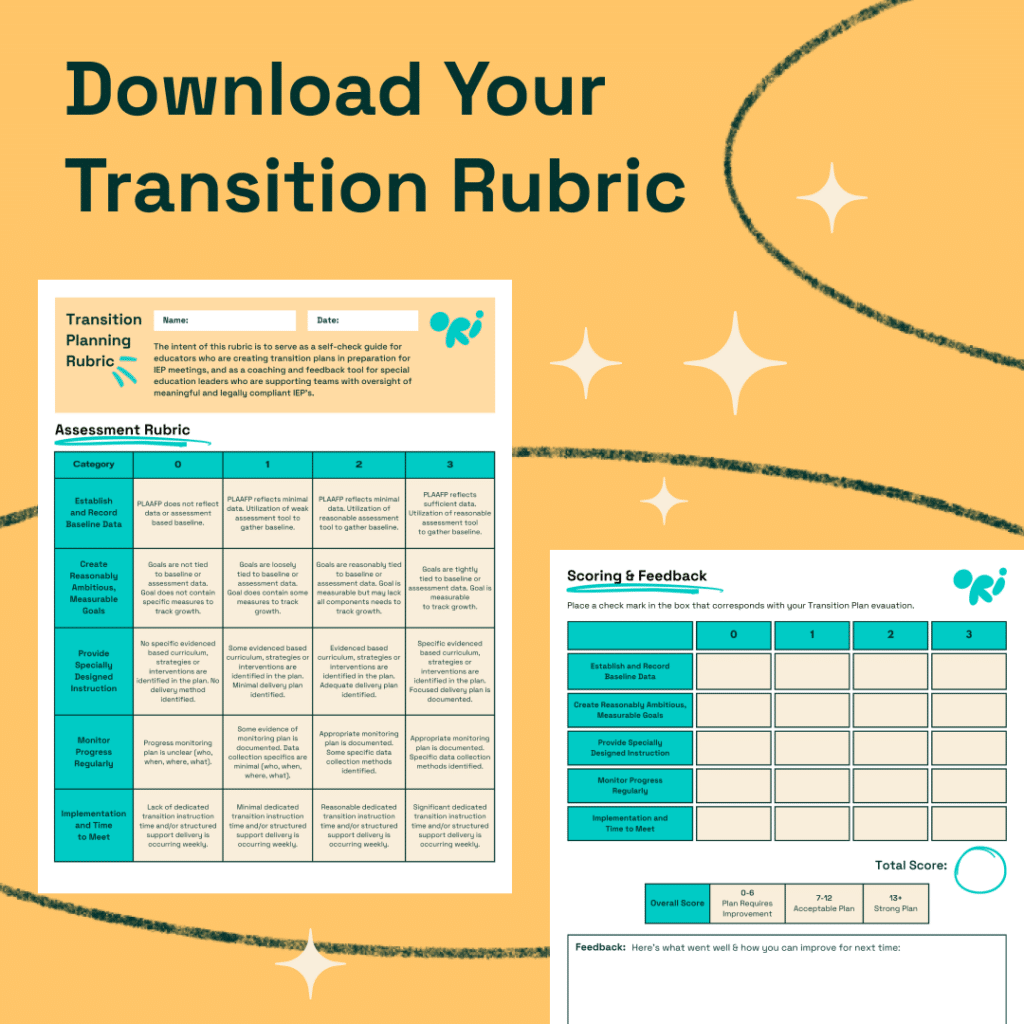

As schools and districts continue to navigate a changing legal landscape with respect to individual education programs, setting appropriate IEP goals as part of every student’s transition out of secondary education has become more crucial than ever.
Recent landmark cases have highlighted the importance of providing high-quality IEPs that lead to measurable progress. Moreover, legal experts have identified the transition planning process as a weak spot for many institutions leading to increased exposure to litigation for those who overlook this key step in special education.
To help ensure your transition plans provide the best possible outcomes for students and minimize the probability of legal action, we’ve consulted with Dr Hulett – an author and leading voice in special education.
In this article, Dr Hulett shares his blueprint for creating SMART goals that ensure transition services are compliant with the latest changes in IEP legislation and provide meaningful results for students.
Key takeaways:
With the U.S. Supreme Court’s rulings in Endrew F. v. Douglas County Schools (2017) and Perez v. Sturgis (2023), substantive compliance has never been more important. Substantive compliance is essentially the responsibility of a school district to create and provide a quality IEP that results in measurable progress.
The Endrew F. case established that every child “must make progress in light of their unique circumstances … and “the child’s IEP must be reasonably ambitious.” In the Perez case, the High Court determined that parents do not need to exhaust administrative remedies prior to seeking financial damages via additional federal statutes (ADA, etc.). Dr Hulett comments that “the combined decisions have resulted in the raising of the bar for school districts with respect to providing a FAPE and that the parents can more easily and quickly sue districts for financial damages when FAPE violations occur. This is certainly not a good recipe for districts that are not ensuring high quality, individualized IEPs.”
He goes on to say: “In the past couple of years, we have observed an increase in transition planning-related due process filings and litigation. The general belief among special education law experts is that attorneys have identified transition planning as a weak area in the IEP process and are using this area as a trojan horse of sorts to initiate formal complaints and litigation.”
One of the most common legal issues with a non-compliant transition plan is often tracked back to the annual goals and objectives. “All too often annual IEP goals and objectives are not individualized, linked to the PLAAFP, measurable, and they do not have baselines.”
So, how do school districts protect themselves from litigation, due process filings, and ensure each child has a truly individualized transition plan in his or her IEP?
According to Dr Hulett: “The best way to create a truly individualized, compliant, and meaningful transition plan and IEP is to ensure each annual goal and objective is SMART.”
Our Transition Planning Rubric is designed to support district leaders and educators in guiding their teams towards excellence in transition planning.
It provides comprehensive criteria that cover the breadth of transition planning, from gauging student engagement to evaluating post-secondary goals and services.
Expand your team’s capabilities and improve the success of IEP meetings.

Here are the key elements Dr Hulett advises to consider when developing SMART IEP goals and short-term objectives:
Specific (S): The goal or objective should be clear, specific, and well-defined. It should focus on a particular skill or outcome that the student needs to achieve.
Measurable (M): The goal or objective should include a way to measure or quantify the student’s progress or success. This could be through data collection, assessments, observations, or other measurable indicators.
Achievable (A): The goal or objective should be realistic and attainable for the student, taking into account their abilities, resources, and supports available. It should consider the student’s current level of functioning and set reasonable expectations for growth.
Relevant (R): The goal or objective should be relevant and directly related to the student’s transition needs and post-secondary goals. It should address skills or outcomes that are important for the student’s successful transition to adulthood, employment, education, or independent living.
Time-bound (T): The goal or objective should have a specific timeline or target date for completion. This helps create a sense of urgency and allows for progress monitoring and adjustments as needed.
When writing short-term objectives, which are steps or benchmarks that lead to the achievement of the overall goal, Dr. Hulett recommends considering the following additional elements:
To demonstrate this approach in practice, let’s consider a SMART IEP goal for a student’s transition planning:
SMART goal: By the end of the academic year, the student will independently research and apply to two post-secondary institutions that align with their career interests.
Short-term objective 1: By [date], the student will research at least three post-secondary institutions and compare their programs, admission requirements, and career opportunities.
Short-term objective 2: By [date], the student will attend college fairs or information sessions to gather further details about the two preferred post-secondary institutions.
Short-term objective 3: By [date], the student will complete and submit applications to the two chosen post-secondary institutions, including all required documents and essays.
Remember to review and revise the goals and objectives periodically to ensure they remain relevant and appropriate for the student’s evolving needs and progress. Collaboration with the student, family, and IEP team is crucial in developing effective and meaningful transition goals and short-term objectives.
Drawing on his years of experience working with teachers and districts across the country, here are Dr Hulett’s top examples of measurable transition goals for students with IEPs that include baseline scores and methods of evaluation:
Note: For ease of understanding and application, specific measurements were not used in the baselines below. Although not a requirement, quantitative baselines are preferred as they are discreet, easily measured, and easy to determine the degree of progress made in a given time period.
Baseline: The student is currently unable to complete a college application.
Goal: By [date], the student will identify and apply to three post-secondary institutions. The student’s progress will be evaluated based on the completion of college applications and submission confirmation.
Baseline: The student has minimal knowledge of career interests and limited exposure to job-seeking skills.
Goal: By [date], the student will participate in a vocational assessment and identify two potential career paths to explore further. The student’s progress will be evaluated based on completion of the vocational assessment and the identification of career options.
Baseline: The student requires assistance in managing personal finances and has limited experience in household tasks.
Goal: By [date], the student will independently create and follow a monthly budget, including income, expenses, and savings. The student’s progress will be evaluated through periodic checks of the budget and financial records.
Baseline: The student has limited involvement in community organizations or activities.
Goal: By [date], the student will actively participate in at least one community organization or club related to their interests for a specific number of hours per month. The student’s progress will be evaluated through documentation of participation hours and involvement in community activities.
Baseline: The student requires support in expressing their needs and preferences in academic or social settings.
Goal: By [date], the student will independently advocate for their accommodations in a classroom or work setting. The student’s progress will be evaluated through observation, self-reporting, and feedback from teachers or supervisors.
Learn more about developing self-advocacy IEP goals and their importance in transition planning.

A transition goal is SMART when it is clear, quantifiable, realistic, aligned with the student’s needs, and has a defined timeline for achievement.
SMART goals guide the creation of individualized, compliant transition plans with measurable objectives for students’ successful move to adulthood.
Non-compliant transition plans increase the risk of litigation and due process filings against school districts for not meeting IEP standards.
It’s important to note that the specific baseline scores and methods of evaluation may vary depending on the student’s individual circumstances, available assessment tools, and resources. The examples of SMART IEP goals laid out by Dr. Hulett, provide a general framework for developing measurable transition objectives, but it’s crucial to individualize the goals and evaluation methods based on the student’s unique needs and context.
“Regular progress monitoring and collaboration with the student, family, and IEP team will help ensure the goals are meaningful and achievable. Individualization, careful measurement, and the appropriate application of specially designed instruction are the hallmarks of a quality and substantively compliant transition plan.”
With Ori’s Transition Curriculum you can greatly facilitate the teaching of essential skills needed for post-secondary success while meeting IEP goals and demonstrating compliance. Get in touch today to discover how your school or district can benefit from our engaging curriculum and progress-tracking tools.
